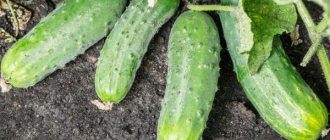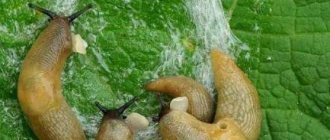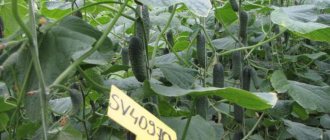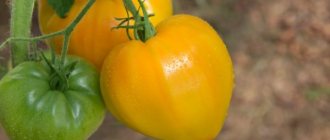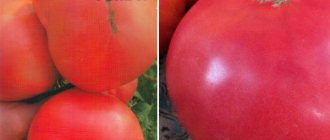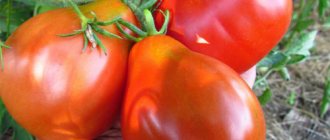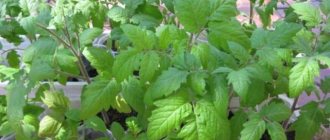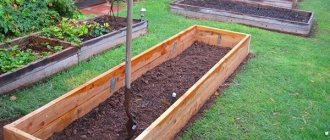Description of the variety
Short review:
“Moscow Evenings” is a hybrid with early ripening. By the time the first harvest is collected, 42-45 days have passed from the appearance of full shoots.
Fruit:
- They have an oval-cylindrical shape;
- Dark green in color, with short white stripes;
- With a coarsely lumpy skin, with white spines, with medium density pubescence;
- With dense pulp without voids, not juicy enough;
- Length - from 12 to 14 cm;
- Diameter - 3.5-4.5 cm;
- The average weight varies from 80 to 110 grams.
Description:
Bushes:
- Indeterminate type, strongly climbing, with medium branching;
- The leaves are medium-sized, with a wrinkled structure, dark green in color, with smooth or slightly wavy edges;
- With female type of flowering;
- Each leaf node produces from 1 to 3 ovaries.
Landing
Seeds are sown for seedlings in April, and in the southern regions - at the end of March. The period for growing seedlings is 25-30 days; overgrown ones will take root less well, and the yield may decrease. Seeds are sown in open ground when its temperature reaches +15 degrees. In the middle zone this is the end of May.
When choosing a place, parthenocarpic cucumbers must be separated from bee-pollinated ones so that the formation of ovaries in both is not disrupted.
Other criteria for selecting a site are:
- Pumpkins, zucchini, squash, cucumbers, melons or watermelons should not be grown on it for the past 3-4 seasons.
- The best predecessors are nightshade crops: tomato, potato, pepper, as well as legumes and cruciferous vegetables (cabbage).
- The site should be located on a sunny hill, although the hybrid Moscow Evenings f1 tolerates shade well.
- A fence from the wind is necessary (corn can be planted around the perimeter of the bed);
- The acidity of the soil should be pH 6-7.
- The soil should be loose, rich in organic matter.
In the fall, the bed is prepared: they dig it up, add manure or compost, and wood ash. To reduce acidity, add dolomite flour, chalk or slaked lime.
Cucumbers are sown to a depth of 1.5-3 cm. The soil in open ground is covered with film after sowing.
You can arrange warm beds in the greenhouse. To do this, place a 30-40 cm layer of manure under the layer of fertile soil. By overheating, it will heat the soil. You can plant cucumbers there when most of the manure has rotted away.
For seedlings, seeds are sown in small peat pots. It is grown in a sunny place at a temperature of +18-20 degrees.
Advantages and disadvantages
The hybrid “Moscow Nights” is characterized by the following advantages:
- High productivity;
- Early ripening;
- Immunity to most diseases;
- Tendency to bunch ovary formation;
- High taste characteristics;
- Good shade tolerance;
- Long period of fruiting;
- Ability to self-pollinate;
- Strongly expressed vegetative and reproductive heterosis.
Harvesting
At the peak of fruiting, greens are harvested every day.
Carefully remove the cucumbers from the bushes, trying not to damage the shoots of the plant. Regular collections are desirable, as this stimulates the culture to form new batches of greens. With infrequent harvesting, the fruits remain on the bushes for a long time, and although they do not overgrow or turn yellow, the overall yield decreases. Other cucumbers remain in their infancy and do not ripen. The hybrid is easy-to-use and, when stored in the refrigerator, lasts for up to 8-10 days without loss of taste and presentation. It is advisable to process cucumbers for preparations within the next 2-3 days after harvesting.
Agricultural technology or proper cultivation: sowing seeds for seedlings, picking
Agrotechnical recommendations:
- Before sowing, seed material is disinfected;
- Afterwards, the seeds are sown in containers filled with nutrient substrate, deepening up to 2 cm;
- As soon as the first shoots hatch, feed the seedlings with organic fertilizers;
- Warm water is used for irrigation;
- Upon reaching the age of 20 days and the presence of 4-6 full leaves, the seedlings are ready for transplantation to a permanent place of growth;
- The distance between seedlings and row spacing is 50 cm;
- The manufacturer recommends maintaining the following density when planting: for greenhouse structures - from 2 to 3 cucumber bushes per 1 m2, for unprotected soil - from 3 to 4 plants per 1 m2.
How to grow in your own backyard?
First you need to grow seedlings. The seeds are disinfected and then sown in boxes filled with soil. The seed is placed to a depth of 20 mm. After the sprouts appear, they are fed with organic fertilizers and watered with warm water. When the seedlings are 20 days old, they are transplanted to permanent beds. The sprouts should have 4-6 leaves. The hybrid planting pattern is 0.5x0.5 m.
The plant can be grown using the following means:
- Bags or plastic bags.
- Hut growing method.
- Use of inclined trellises.
In the first case, plastic bags with a volume of more than 100 liters or ordinary canvas bags are used. Prepared soil (peat, sand, humus) is poured into them. A stake 200 cm long is driven into the center of the container. Low plastic tubes are installed around it for watering the plants. 3 bushes are planted in each package or bag.
3 pegs are driven in around each improvised bed. A fishing line is pulled over them, and its free end is attached to a high stake driven into the middle of the bag. Relying on the fishing line, the plants will rise.
With the hut method of growing a hybrid, seedlings are planted in a circle, the diameter of which is 180-200 cm. A tall stake with hooks attached to it is driven into the center. A small peg is installed near each bush, on which one end of the fishing line is wound, and the other is tied to a hook on a pole. The plants cling to the fishing line with their tendrils and rise.
When using inclined trellises, the bushes are planted on narrow beds in 2 rows running parallel to each other. At the end and beginning of each row, high pegs are driven in. They are installed at an angle. All 4 pegs are connected by a long, horizontal strip, from which a stretched fishing line descends to each plant. The bushes are attached to it with mustaches and creep upward.
Care
What care does the hybrid “Moscow Evenings” need:
- It is advisable to water in the evening, after sunset. It is recommended to use water heated by sunlight in a barrel. The hybrid requires abundant watering. The optimal solution would be to install a drip irrigation system. The system will provide direct moisture to the root system. The result will be rapid plant growth, reduced water consumption, and weeds will stop growing. In most cases, simultaneous fertilizing is carried out during irrigation;
- Feed the crop once every 8-10 days. At the first stage, nitrogen fertilizers will be required. When flowers appear on the bushes, potassium and phosphorus mixtures are used as fertilizing. During fruit formation, the hybrid is fed with mineral complexes;
- Loosen at intervals of 1-2 times a week;
The procedure improves air access to the root system of the plant, and also gets rid of parasitic pests living on the roots of the crop.
- By weeding, the likelihood of young cucumber bushes being damaged by fungal diseases as a result of infection from weeds is reduced. Also, thanks to weeding, dangerous garden pests living on weeds are destroyed. Weeding is carried out once a week.
How to grow cucumbers Moscow evenings on the plot
Many gardeners, in pursuit of high yields, practice different methods of growing cucumbers. The Moscow Nights F1 hybrid is no exception.
Growing in bags or plastic bags
For such a “bed”, bags with a volume of at least 100 liters or bags are suitable.
16 excellent varieties of plums for the Moscow region
- Fill the containers with prepared nutrient soil.
- A high, about 2 m peg is driven into the center.
- Low hollow tubes made of any material are inserted around it - watering will be carried out through them.
- 3 plants are planted in each bag.
- Around the bag, 3 low pegs are driven in, from which the fishing line is stretched and attached to a tall stake driven in the middle. The cucumbers will rise up along this line.
- As a result, the entire structure looks like a hut.
Advice. Sugar bags work great as containers.
This method is especially convenient in small areas - bags or packages do not take up much space.
Growing in the form of a hut
- Cucumber seedlings are planted in a circle with a diameter of 2 m.
- A tall stake with hooks on top is driven into the center.
- A peg is installed near each plant.
- One end of the fishing line is attached to the hooks of the central stake, and the other to the plant stake. The cucumber's whiskers cling to the fishing line and rise up.
- The result is a structure very reminiscent of a hut.
Growing on a sloped trellis
- Cucumbers are planted in narrow beds in two parallel rows.
- At the beginning and at the end of each row, high pegs are driven in at an angle.
- A horizontal rail is installed on top of the pegs - one for two rows.
- A fishing line is stretched from the slats to each plant and secured.
- The cucumbers cling to the rail with their antennae and rise.
The method of growing cucumbers on a trellis is very popular among gardeners. Thanks to this cultivation, the plants are always well lit, not crowded and well ventilated. It is very convenient to remove the fruits and they are all visible.
Diseases and pests
“Moscow Nights” are highly resistant to olive spot, cucumber mosaic virus, powdery mildew and peronospora.
If dangerous pests, such as aphids, mites or flying insects, appear on the site, the leaves and stems of plants are treated using chemical toxic substances. At the same time, the hybrid is treated with copper sulfate or soap solution. To destroy pests, you can use folk remedies, for example, infusion of onion or garlic peels.
Application
Hybrid Mother-in-law F1 has excellent taste, crispy and aromatic flesh. These cucumbers are used fresh and lightly salted, for salads and pickling. As a result of canning, no voids are formed in them. Preparations can be made from gherkins of this variety by picking cucumbers from 5 to 8 cm long. Such pickles can be stored well all winter without exploding. They are suitable for preparing delicious okroshka in the winter. You can freeze the fruits whole and grate them into a dish without defrosting, using a coarse grater.
Freshly picked cucumbers can be pickled immediately. They also keep well in the cold for about 5-7 days. However, they should be washed first and, without drying, wrapped in a bag. In this case, before canning, the fruits must be kept in cool water for 8 hours, changing it to new water every two hours.
Watch the video! Cucumber harvest
Harvesting
At the peak of fruiting, greens are harvested every day. Carefully remove the cucumbers from the bushes, trying not to damage the shoots of the plant. Regular collections are desirable, as this stimulates the culture to form new batches of greens.
With infrequent harvesting, the fruits remain on the bushes for a long time, and although they do not overgrow or turn yellow, the overall yield decreases. Other cucumbers remain in their infancy and do not ripen. The hybrid is easy-to-use and, when stored in the refrigerator, lasts for up to 8-10 days without loss of taste and presentation. It is advisable to process cucumbers for preparations within the next 2-3 days after harvesting.
